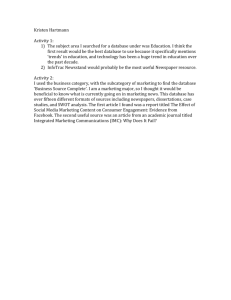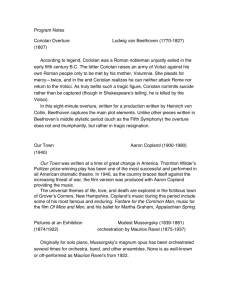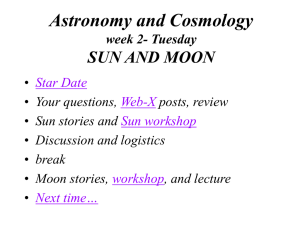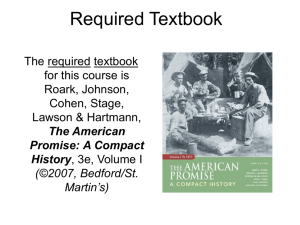Gurdjieff International Review http://www.gurdjieff.org/mangan1.htm
advertisement
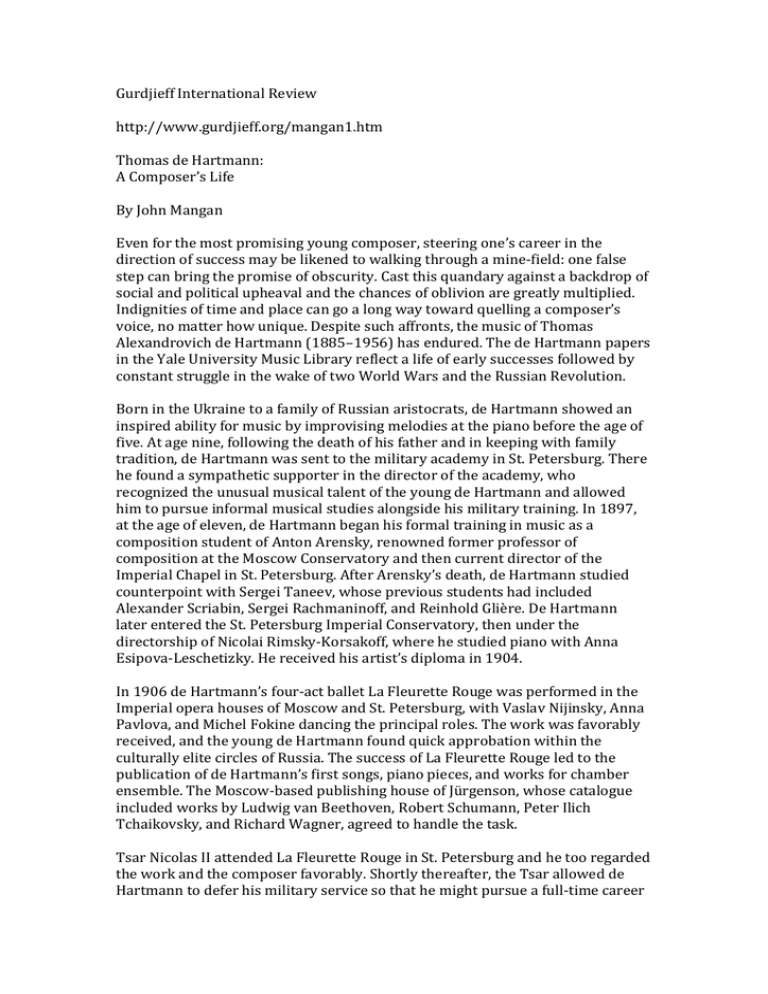
Gurdjieff International Review http://www.gurdjieff.org/mangan1.htm Thomas de Hartmann: A Composer’s Life By John Mangan Even for the most promising young composer, steering one’s career in the direction of success may be likened to walking through a mine-field: one false step can bring the promise of obscurity. Cast this quandary against a backdrop of social and political upheaval and the chances of oblivion are greatly multiplied. Indignities of time and place can go a long way toward quelling a composer’s voice, no matter how unique. Despite such affronts, the music of Thomas Alexandrovich de Hartmann (1885–1956) has endured. The de Hartmann papers in the Yale University Music Library reflect a life of early successes followed by constant struggle in the wake of two World Wars and the Russian Revolution. Born in the Ukraine to a family of Russian aristocrats, de Hartmann showed an inspired ability for music by improvising melodies at the piano before the age of five. At age nine, following the death of his father and in keeping with family tradition, de Hartmann was sent to the military academy in St. Petersburg. There he found a sympathetic supporter in the director of the academy, who recognized the unusual musical talent of the young de Hartmann and allowed him to pursue informal musical studies alongside his military training. In 1897, at the age of eleven, de Hartmann began his formal training in music as a composition student of Anton Arensky, renowned former professor of composition at the Moscow Conservatory and then current director of the Imperial Chapel in St. Petersburg. After Arensky’s death, de Hartmann studied counterpoint with Sergei Taneev, whose previous students had included Alexander Scriabin, Sergei Rachmaninoff, and Reinhold Glière. De Hartmann later entered the St. Petersburg Imperial Conservatory, then under the directorship of Nicolai Rimsky-Korsakoff, where he studied piano with Anna Esipova-Leschetizky. He received his artist’s diploma in 1904. In 1906 de Hartmann’s four-act ballet La Fleurette Rouge was performed in the Imperial opera houses of Moscow and St. Petersburg, with Vaslav Nijinsky, Anna Pavlova, and Michel Fokine dancing the principal roles. The work was favorably received, and the young de Hartmann found quick approbation within the culturally elite circles of Russia. The success of La Fleurette Rouge led to the publication of de Hartmann’s first songs, piano pieces, and works for chamber ensemble. The Moscow-based publishing house of Jürgenson, whose catalogue included works by Ludwig van Beethoven, Robert Schumann, Peter Ilich Tchaikovsky, and Richard Wagner, agreed to handle the task. Tsar Nicolas II attended La Fleurette Rouge in St. Petersburg and he too regarded the work and the composer favorably. Shortly thereafter, the Tsar allowed de Hartmann to defer his military service so that he might pursue a full-time career in music. Seizing the opportunity, de Hartmann immediately departed for Munich to study with the famous conductor and former pupil of Wagner, Felix Mottl.1 In 1908 Munich was a magnet for artists of all kinds—a center of creative activity surpassed only by Paris and Vienna. Not long after his arrival, de Hartmann attended an art exhibition that displayed works by the then unknown painters Vincent van Gogh, Paul Gauguin, and Wassily Kandinsky. De Hartmann later recounted: “Music in Germany had reached an impasse . . . it seemed clear to me that the new forms and techniques had to be found, and more than anything else I wished to find my own way. Soon I found it through the art of painting.”2 De Hartmann was introduced to Kandinsky by mutual friends. Although Kandinsky was twenty years the composer’s senior, the two formed a strong bond of friendship that lasted until Kandinsky’s death, a friendship reflected by the numerous letters in the de Hartmann papers from Kandinsky as well as de Hartmann’s personal reflections upon the artist’s death. Kandinsky, born in Moscow on 4 December 1866, also came from an upper-class Russian family. At the age of five, his family moved to Odessa where he received his first lessons in music and art. In 1886 he entered the University of Moscow where he studied law and economics. In 1895, at an exhibition of French painters in Moscow, Kandinsky was dumbfounded by Monet’s Haystack in the Sun. The impressionistic handling of color and light made the central object of the painting, from Kandinsky’s vantage point, momentarily unrecognizable, causing him to question whether, in his own painting, the use of representational objects could be disposed of altogether. This experience contributed profoundly to the artist’s early experiments with complete abstraction. Newly inspired by this artistic epiphany, Kandinsky promptly turned down the offer of a law professorship at the University of Dorpat (Tartu, Estonia) and went to Munich, where he became an overage art student enrolling first at a private school run by Anton Azebé and, later, at the Munich Academy.3 Wassily Kandinsky, seated, Thomas de Hartmann, far right, Munich, 1911; also pictured, left to right: Maria Marc, Franz Marc, Bernhard Koehler, Heinrich Campendonk. Courtesy The Thomas de Hartmann Archives, Yale University Music Library. Kandinsky’s quest for the abstract in visual art was analogous to de Hartmann’s search for new compositional techniques in music. Further, Kandinsky believed that exact equivalents could be found within the color spectrum for individual musical pitches.4 As their friendship developed, de Hartmann became increasingly intrigued by the scope of Kandinsky’s creative vision. De Hartmann was fascinated by the artist’s assertion that any means of expression was permitted if it helped the artist convey his “inner sound.”5 Kandinsky soon introduced de Hartmann to Alexander Sacharoff (1886–1963), a young Russian dancer. Sacharoff, who had little interest in classical ballet, was creating new forms of dance that combined everyday movements with broader, more expressive gestures. He was further influenced by eurhythmics, as developed by the Swiss educator Emile Jaques-Dalcroze. At Kandinsky’s suggestion, Sacharoff choreographed solos based on figures from Greek vases. In doing so, he pre-empted by two years Nijinsky’s utilization of these same kinds of figures for L’Après-midi d’un faun.6 Sacharoff’s choreography with de Hartmann’s musical accompaniment was cause for much discussion around Munich in 1910.7 With Kandinsky, this multifaceted triumvirate began holding all-night sessions of collaborative improvisation with de Hartmann at the piano, Kandinsky shouting out dramatic scenarios based loosely on Russian folklore, and Sacharoff interpreting the music and storyline in dance. This exploration of the interrelatedness of their creative media led first to a setting of the Greek legend Daphnis and Chloe and later, in 1909, to the creation of the seminal one-act opera Der gelbe Klang. Neither work was staged at that time.8 Among the most intriguing items in the de Hartmann papers are those related to Der gelbe Klang. This Gesamtkunstwerk with its yellow giants, sets of continuously changing shape, seemingly incongruous text and choreography, and lighting cues beyond what early twentieth century technology could effectively realize, was of great importance to the early avant-garde movements of both music and art. A perplexed Stanislavsky, then at the helm of the Moscow Art Theater, declined de Hartmann’s persistent requests to stage the work. Other attempts to have the opera performed by the Künstlertheatre in Munich in 1914 were interrupted by the outbreak of World War I. Whether or not de Hartmann ever completed a score for the opera is unknown; all that remains from the original music are the handful of sketch pages in this collection.9 When Der gelbe Klang was given its American premiere as part of a Guggenheim Museum retrospective on Kandinsky in 1982, Gunther Schuller used these sketches as well as other music in the de Hartmann papers to reconstruct, or construct for the first time, a full orchestral score.10 In 1912 de Hartmann published an article entitled “Über die Anarchie in der Musik,” which appeared in the avant-garde periodical Der blaue Reiter, published by Kandinsky and Franz Marc. De Hartmann posited that in the process of artistic creativity external laws do not exist. “In all the arts, and especially in music, every means that arises from an inner necessity is right . . . the correspondence of the means of expression with inner necessity is the essence of beauty in a work.”11 Kandinsky’s influence on de Hartmann’s conceptual understanding of creativity was never more palpable. During a return visit to St. Petersburg, de Hartmann had met and later married Olga Arkadaevna Schumacher (1885–1979), the daughter of a prominent government dignitary. The young couple returned to Munich, but World War I soon intervened and de Hartmann was ordered back to his regiment in St. Petersburg (Petrograd, by then). As a Russian officer, he made several visits to the front. Despite being continually active in the war effort, he also managed to compose Forces de l’amour et de la sorcellerie, a marionette opera that was performed in St. Petersburg in 1915. Throughout his life, de Hartmann had been preoccupied with the search for a higher level of spiritual understanding: “Without inner growth, there is no life for me.”12 This spirituality may have been engendered by his great uncle Eduard von Hartmann (1842–1906), who wrote Philosophy of the Unconscious in 1877,13 but also found an avocation in music, composing songs and writing on the topic of musical aesthetics. Kandinsky, also concerned with higher planes of understanding, believed art to be “one of the most powerful agents of the spiritual life.”14 It is likely that de Hartmann and Kandinsky had many and varied discussions on the topic of spirituality. Kandinsky’s commitment to abstraction was clearly interwoven with his spiritual beliefs, while de Hartmann, too, was seeking this same cohesion in his own work.15 In this case, however, age was proportional to wisdom and the older Kandinsky was more self-assured in his personal understanding of the spiritual realm and how it related to his craft than was the younger de Hartmann. In 1916 de Hartmann’s spiritual life was profoundly affected when, in a prostitute-filled café on the Nevsky Prospect in St. Petersburg, he was introduced to Georgi Ivanovitch Gurdjieff (1872–1949).16 De Hartmann later wrote in his and Olga’s extraordinary memoir Our Life with Mr. Gurdjieff, “After this meeting, my life became a sort of fairy tale.”17 Olga de Hartmann amplified: “Mr. Gurdjieff was an unknown person, a mystery. Nobody knew about his teaching, nobody knew his origin . . . but whoever came into contact with him wished to follow him, and so did Thomas de Hartmann and I.”18 And follow him they did. They remained in his immediate orbit and under his spiritual tutelage for the next twelve years, with Thomas serving as, among other things, accompanist and composer-in-residence, while Olga served as Gurdjieff’s personal secretary.19 Gurdjieff, having spent much of his life traveling to spiritual centers in the Middle and Far East, appeared in St. Petersburg in 1913 under a cloak of mystery and intrigue. He was a nomadic Georgian mystic, the core of whose wisdom was centered around the idea that man was not born with an immortal soul. With the right kind of spiritual work, however, an immortal soul could be formed. Without undertaking such work under Gurdjieff’s carefully measured guidance, a person was no better than a machine, leaving their art, life, and culture without meaning.20 Pre-World War I Europe was fertile ground for the kind of occultism and mysticism that proposed the creation of a utopian epoch. “Enlightened” individuals proposed leading the uninitiated into understanding the higher realities of the cosmic world. Gurdjieff’s ideas, coupled with an intensely compelling personality, won him a great number of devoted followers. In 1917 revolution brought an end to Tsarist rule in Russia, and with it, chaos and uncertainty. Members of the nobility and military officers, including de Hartmann, feared angry reprisals from the Bolsheviks. De Hartmann craftily secured travel papers through his crumbling military contacts, and he and Olga immediately left St. Petersburg. They headed for the Caucasus, a rugged mountainous area in southern Russia, hoping to make a rendezvous with Gurdjieff. (The following day, military police arrived at the de Hartmann’s apartment in St. Petersburg to arrest them, only to find it empty). The de Hartmanns soon met up with Gurdjieff in Essentuki and began a period of intense spiritual work. With Gurdjieff as their guide and with a group of other adherents, they continued their extraordinary escape through the Caucasus, first to Sochi, and later to the imperial stronghold of Tiflis (Tbilisi). Upon arriving in Tiflis, de Hartmann was reunited with his friend Nicolas Tcherepnin, who was head of the conservatory there. Tcherepnin, who had also fled the melee in St. Petersburg, immediately invited de Hartmann to take over the composition class at the conservatory, where one of the pupils in that class was Tcherepnin’s own son, Alexander. De Hartmann also became artistic director of the Imperial opera house in Tiflis. Olga, an amateur singer, was invited by Tcherepnin to perform, under his baton, roles in Carmen and Rigoletto. With the opera season not far off, the well-known artist Alexander de Salzmann, a mutual friend of both de Hartmann and Kandinsky from their days in Munich, was commissioned to paint the scenery.21 De Salzmann and his wife Jeanne soon became ardent Gurdjieff followers.22 Thomas de Hartmann rapidly found himself at the center of cultural and artistic life in Tiflis. He now had students, an orchestra and opera company for which to write and conduct, and a commission to compose incidental music for the Moscow Art Theater. Gurdjieff, in a typically idiosyncratic gesture, requested that de Hartmann give up all music-related activity so that the composer might better devote himself to the “work.” De Hartmann, in a rare act of defiance, refused, allowing that he would make himself available for the “work” when needed, but would use the rest of his time to earn a living.23 In 1920 the de Hartmanns followed Gurdjieff to Constantinople, where Thomas continued an active musical life, organizing an orchestra made up largely of Russian musicians displaced by the Revolution. Conditions there soon deteriorated, however, and Gurdjieff, with characteristic prescience, evacuated the de Hartmanns and his other followers just prior to the outbreak of civil war in Turkey. Seeking refuge, the group went to Berlin where they remained for more than a year. Gurdjieff, realizing that his teaching and its devotees were in need of a more permanent center of operations, moved to Paris, arriving on French Independence day, 1922. Once there, Olga shrewdly negotiated the rental of an estate in nearby Fontainebleau—the Prieuré of Avon. It was there, in a former monastery, that the most enduring legacy of Gurdjieff’s teachings was established. His Institute for the Harmonious Development of Man, originally founded in Tiflis, now had a roof under which it could prosper.24 Manual and spiritual labor on the Fontainebleau estate was rigorous, though de Hartmann still found time to compose. Initially, he worked only on short pieces that served as accompaniment for the exercises, both physical and otherwise, that formed part of Gurdjieff’s training regime. In 1923 de Hartmann composed an orchestral score for a demonstration of the sacred gymnastics at the Théâtre des Champs-Elysées. Disheartened at the dress rehearsal by the lackluster performance of the orchestra, he received encouragement from Nicolas and Alexander Tcherepnin, who were both in attendance. The minor success of the actual public performance provided impetus for the planning of future performances in the United States. With the usual last-minute uncertainty to which they had become accustomed, Gurdjieff’s troupe sailed for New York in January of 1924. Demonstrations soon followed in small venues in New York, Boston, Philadelphia, and Chicago. The success of the Chicago performance, for a group of French dignitaries, led to a return engagement in New York at Carnegie Hall. Returning to Fontainebleau on the night of 8 June 1924, Gurdjieff sustained a near-fatal injury in an automobile accident. The prosaic explanation suggests that his notoriously appalling driving habits caused him simply to lose control of his Citroën. An intricate sequence of events preceding this mishap, however, gave rise to suspicions that darker forces may have been at work.25 In any case, with Gurdjieff’s ensuing convalescence, financial matters at the estate quickly deteriorated. In an effort to keep the teetering ship upright and afloat, de Hartmann put aside any residual aristocratic pride and accepted commissions to compose film music (pseudonymously as Thomas Kross). Other Gurdjieff loyalists also yielded their decorum: Alexander de Salzmann painted murals in Montmarte cafés while Olga Hinzenberg became an attendant in a women’s lavatory.26 Gradually, Gurdjieff’s situation improved and life on the estate regained a sense of normalcy, though his countenance was noticeably altered. He was aloof and, at times, belligerent. Despite these obstacles, he began to compose, with de Hartmann, a series of new pieces: “Mr. Gurdjieff sometimes whistled or played on the piano with one finger a very complicated sort of melody—as are all Eastern melodies . . . to grasp these melodies and write them down in European notation, required a kind of tour de force and very often—probably to make the task more difficult for me—he would replay it a little differently.”27 The bestknown material from their work together is the Sacred Music, solo piano pieces composed purely for the sake of listening and meditation. The de Hartmanns remained with Gurdjieff until 1929 when, for unexplained reasons, he severed ties with all of his oldest students. Consequently, the de Hartmanns moved to Garches, a small town just outside Paris. Although they never saw Gurdjieff again, their experiences with the spiritual leader remained important to them for the rest of their lives. Extant in the papers are letters, epigrams, transcribed conversations, and a ballet scenario by Gurdjieff entitled Struggle of the Magicians.28 The de Hartmanns, having left behind most of their wealth when they fled Russia, were now faced with the unfamiliar task of supporting themselves. No longer was Gurdjieff there to arrange for their well-being. With the unstinting support of Olga, Thomas de Hartmann decided to resume his composing career. Through teaching, and with Belaieff Editions retaining him with a small stipend, he was able to earn a modest living. He continued his friendship with Kandinsky and found a new and supportive friend in the cellist, Pablo Casals.29 With the Nazi occupation of France, the de Hartmanns were, once again, forced from their home. Displaced by the advancing army, they sought refuge in an abandoned building where, miraculously, they found a piano in working condition. De Hartmann continued to work under these unfavorable circumstances, principally on Esther, an opera based on the play by Jean Racine. De Hartmann’s own copy of a 1768 edition may be found in the collection. Several concertos for various instruments, a symphony, and a cello sonata were also completed during this period. Many of these works were performed in Paris after the war, including the piano concerto, which de Hartmann himself performed under the auspices of the Concerts Lamoureux with Eugène Bigot conducting. In 1950 the de Hartmanns moved to New York City, where they settled on the upper west side of Manhattan. Before long, de Hartmann began to receive occasional offers to lecture and teach. One opportunity took him to London, where he gave a series of lectures outlining his belief in the interrelatedness of the arts. The American design visionary Frank Lloyd Wright heard of these lectures and invited de Hartmann to work with the students at Taliesin West, Wright’s architectural commune in Arizona. It is not surprising that Wright was interested in de Hartmann’s work, given that Wright had married, in June of 1928, Olga Hinzenberg, one of Gurdjieff’s most loyal former pupils.30 Wright believed that musical composition and architectural design were closely related skills. De Hartmann, perhaps with this in mind and certainly aware of the architect’s friendship with Gurdjieff, accepted the invitation. An autographed copy of Wright’s The Story of the Tower remains in de Hartmann’s papers. De Hartmann later returned to New York, where he continued to compose, performed occasionally, and began work on a memoir of Gurdjieff. On 16 April 1956 an American debut concert of de Hartmann’s music was scheduled to be performed in New York’s Town Hall, but on 28 March, he died suddenly of a heart attack. His students, however, went ahead and performed the concert as a memorial tribute. Olga de Hartmann devoted the rest of her life to promoting interest in her husband’s music both in the United States and abroad. She lived her final years at the center of a group of Gurdjieff followers in Santa Fe, New Mexico. In 1979, within days of shipping the last of her husband’s papers to the Yale University Music Library, she died at the age of 94.31 De Hartmann’s output as a composer included four symphonies, several operas, concertos, sonatas, and songs with texts by Marcel Proust, Paul Verlaine, James Joyce, and Percy Bysshe Shelley, as well as fifty-three film scores.32 By his early twenties he was one of the best-known living composers in all of Russia. His music was enthusiastically supported by performers and conductors such as Leopold Stokowski, Bigot, Casals, Paul Tortelier, and Jean Pierre Rampal. The fragmented path his life was to follow brought him into direct contact with some of the most intriguing personalities of the century. The turbulent historical events through which he lived may, however, have kept de Hartmann’s music from reaching a wider audience. With the de Hartmann papers now available for scholarly examination, the opportunity is ripe for a new look at this composer’s unique contributions.33 ~•~ 1 Biographical information regarding the early life of de Hartmann is taken from various primary sources in the de Hartmann papers (Mss 46), Yale University Music Library Archival Collection. 2 Taken from de Hartmann’s typescript remembrance entitled “About Kandinsky.” (Yale Music Library, Mss 46, box 24, folder 215). Mussorgsky, another among many composers who sought inspiration from the visual arts, used the paintings of de Hartmann’s uncle, Victor Alexandrovich Hartmann, as the scenic backdrop for his 1874 work, Pictures at an Exhibition; see Alex Shoumatoff, Russian Blood, a Family Chronicle (New York: Coward, McCann & Geoghegan, 1982), p. 233. 3 Kandinsky in Munich 1896–1914, (New York: Guggenheim Foundation, 1982), p. 303. 4 Kandinsky felt that once a system of identifying these equivalents was developed, they could be combined to create contrasting, rather than corresponding, effects. His contemporary, Alexander Scriabin, was also exploring the relationship between sound and color; see John E. Bowlt and Rose-Carol Washton Long, eds., The Life of Vasilii Kandinsky: On the Spiritual in Russian Art, (Newtonville, Mass: Oriental, 1980), p. 52. Kandinsky’s work soon reflected his new thinking on the subject of color with his use of schemes considered to be visually dissonant. Interestingly, in 1911 he began a long friendship with Arnold Schoenberg, who was exploring, to some, a more tangible medium of dissonance. 5 De Hartmann, “About Kandinsky,” De Hartmann papers (Mss 46, box 24, folder 215). 6 Ian Strasfogel, “The Creation of The Yellow Sound,” from the program book for Der gelbe Klang (New York: Guggenheim Museum, 1982), p. 3–5. 7 Sacharoff commented: “I do not dance to the music; I dance the music;” quoted in Ian Strasfogel, “A Radical Vision.” Opera News, (30 January, 1982): p. 10. 8 Ibid. 9 In the 1950s de Hartmann recorded, at the piano, some of the music to Der gelbe Klang. Although of poor quality, this recording clearly contains additional material not found in the sketches. It is difficult to determine, however, the accuracy of this recording. Whether de Hartmann was playing from memory (trying to remember music he composed forty years earlier) or from notation (with extemporaneous elaborations) is unknown. Gunther Schuller, “The Case of Thomas de Hartmann,” from the program book for Der gelbe Klang (New York: Guggenheim Museum, 1982), p. 6–7. 10 Thomas de Hartmann, Der gelbe Klang, ed. Gunther Schuller (Newton Center, Mass: Margun Music, 1981). 11 Thomas de Hartmann, “On Anarchie in the Music,” in The blaue Reiter Almanac, Documents of 20th-Century Art (New York: Viking, 1974), p. 113. 12 Thomas de Hartmann, Our Life with Mr. Gurdjieff (San Francisco: Harper and Row, 1983), p. 3. 13 Eduard von Hartmann, Philosophy of the Unconscious (New York: Macmillan, 1884). 14 Rose-Carol Washton Long, Kandinsky: The Development of an Abstract Style (Oxford: Clarendon Press, 1980), p. 13. 15 Ibid. 16 Gurdjieff often would meet prospective newcomers in unseemly places in order to test their character and resolve. Whereas most teachers would attempt to make a good impression at the outset by conveying an aura of seriousness and importance, Gurdjieff favored the antithesis. The suggestion of charlatanism intentionally and enigmatically permeated much of his work. See de Hartmann, Our Life with Mr. Gurdjieff, p. 49. 17 Ibid., p. 4 18 Ibid., p. xvii. 19 Olga’s knowledge of languages and natural business acumen made her a valuable member of Gurdjieff’s inner circle. It was to her that he dictated, in large part, his esoteric and, at times, perplexing opus All and Everything: Beelzebub’s Tales to His Grandson (New York: E. P. Dutton, 1961). 20 De Hartmann, Our Life with Mr. Gurdjieff, p. 2. 21 Ibid., p. 79. 22 Jeanne de Salzmann, then an instructor of the Dalcroze system of dance in Tiflis, took great interest in Gurdjieff’s exercises known as sacred gymnastics. A public demonstration was held where the two presented their respective movement idioms, cf. de Hartmann, Our Life with Mr. Gurdjieff, p. 80. Olga Hinzenberg (known as Oglivanna), wife of Russian architect Vlademar Hinzenberg, also joined Gurdjieff’s circle of followers in Tiflis, becoming an adept interpreter of the gymnastics. In 1928 she married the American architect Frank Lloyd Wright. 23 In early 1920 de Hartmann received a large sum of money from Russian composer Meliton Balanchivadze (father of choreographer George Balanchine) to orchestrate some of Balanchivadze’s music. The money had to be returned, however, because the work was never completed due to Gurdjieff’s insistence on a hasty move to Constantinople; see de Hartmann, Our Life with Mr. Gurdjieff, p. 93–97. 24 Gurdjieff arranged for the purchase of the skeleton of a French Air Force hangar, which was fashioned into a great hall. This space served as a “study house” with a special platform for the rehearsing of the sacred gymnastics. Windows were installed and later painted by Alexander de Salzmann; see de Hartmann, Our Life with Mr. Gurdjieff, p. 119. 25 Theories that someone was trying to eliminate Gurdjieff, and that he may have been aware of this, have surfaced since this incident. Just prior, he warned of famine on the estate, gave Olga de Hartmann power of attorney for all financial resources of the Prieuré, had a mechanic completely inspect his car (paying special attention to the steering) and insisted that Olga, who was accustomed to returning with him, take a train back to Fontainebleau on the fateful night. See James Moore, Gurdjieff: The Anatomy of a Myth, (Rockport, Mass: Element, 1991), p. 206. 26 Ibid., p. 208. 27 De Hartmann, Our Life with Mr. Gurdjieff, p. 142. 28 Gurdjieff’s Struggle of the Musicians incorporated movements from the sacred gymnastics, which were inspired in part by the movement of the planets; see P. D. Ouspensky, In Search of the Miraculous (New York: Harcourt, Brace & World, 1949), p. 16. This ballet, originally begun in Tiflis in 1919, was in a state of continuous revision for many years and was, despite Gurdjieff’s many public and private notices, never performed. Later, Gurdjieff’s most broad-minded disciples determined that this perpetual state of cancelled expectation was an integral element of the “work.” 29 De Hartmann’s Concerto d’aprés une Cantate de J. S. Bach, for cello and orchestra, was dedicated to Casals. 30 Gurdjieff and Wright met at Taliesin East, Spring Green, Wisconsin, in June of 1934. Gurdjieff came to Spring Green as a recipient of the newly founded Taliesin fellowship. Gurdjieff’s influence on Wright via his wife, and later by the mystic himself, should not be underestimated. Though Wright publicly shunned the possibility, the training regime at Taliesin in the mid 1930s strongly reflected Gurdjieffian ideology; see Moore, Gurdjieff: The Anatomy of a Myth, p. 364. These two weathered visionaries, though from different disciplines, seemed to hold each other in a special mutual regard. They visited one another often during their fifteen-year association. The Wright literature is replete with interesting anecdotes involving Gurdjieff, e.g., discussions of Gurdjieff’s extraordinary culinary skills, which he bestowed upon his hosts at Taliesin (one such herbal concoction supposedly greatly improved Wright’s kidney stone condition), and the uncovering of the FBI’s voluminous file on Wright. Wright was suspected by FBI Director, J. Edgar Hoover of operating a “religious cult” in the 1950s at Taliesin. Wright’s disciples conducted “dances to the moon” and regularly were “brainwashed by a bald-headed Soviet mystic, Georgi Gurdjieff,” Hoover wrote in a 1954 memo; see the Journal of the Taliesin Fellows 3 (Winter 1990-1991), p. 16. 31 Olga de Hartmann felt that her husband’s papers would complement those of former Gurdjieff disciple P. D. Ouspensky, already in the Beinecke Rare Book Library at Yale. Prior to sending the collection to the Yale Music Library, however, Olga removed most of the Gurdjieff-related material, sending it instead to Thomas C. Daly, a Gurdjieff follower in Montreal. De Hartmann’s Prieuré sketchbooks and his personal thoughts regarding the essence of the Gurdjieff / de Hartmann music are, according to Daly, extant in that material. Also in the collection is a manuscript copy of Olga’s own memoirs, which Daly excerpted and interspersed in a new edition of Our Life with Mr. Gurdjieff (New York: Harper and Row, 1983). 32 The 1979 film Meetings with Remarkable Men, based on Gurdjieff’s autobiography of the same title, is scored with Gurdjieff / de Hartmann music from the 1920s. 33 The Thomas de Hartmann papers consist of 15 linear feet of material in 31 boxes. His life and career are documented by manuscript and published music, correspondence, concert programs, reviews, newspaper clippings, and photographs. A 79 page register (Mss 46) of this collection is available from the Yale University Music Library, P.O. Box 208320, Yale Station, New Haven, CT 06520-8320. ~•~ John R. Mangan is currently the Dean of Jonathan Edwards College, Yale University. This essay is reprinted from Notes: Quarterly Journal of the Music Library Association, Vol. 53, No. 1 (September 1996), pp. 18–29, by permission of the Music Library Association. Copyright © 2004 Gurdjieff Electronic Publishing Featured: Fall 2004 Issue, Vol. VIII (1) Revision: November 1, 2004
